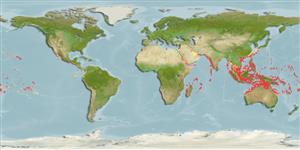Common names from other countries
Environment: milieu / climate zone / depth range / distribution range
Ecologia
marinhas associadas(os) a recifes; intervalo de profundidade 5 - 65 m (Ref. 90102), usually 20 - 65 m (Ref. 27115). Tropical; 22°C - 28°C (Ref. 27115); 35°N - 25°S
Indo-Pacific: Red Sea and Kenya east to Hawaiian Islands, Fanning Islands and Samoa; northward to Japan south to Australia. Apparently not found off New Zealand (Ref. 8991).
Tamanho / Peso / Idade
Maturity: Lm ? range ? - ? cm
Max length : 45.0 cm SL macho/indeterminado; (Ref. 8991); common length : 35.0 cm SL macho/indeterminado; (Ref. 9645)
Espinhos dorsais (total) : 3 - 4; Raios dorsais (total) : 43 - 47; Espinhos anais: 1; Raios anais : 37 - 40.
Found on outer reef slopes, hovering above the bottom. They swim often high above the substrate to pick prey from the substrate with their excellent eyesight (Ref. 48635). Tends to swim away from its pursuer rather than enter its burrow (Ref. 1602). Solitary or in pairs (Ref. 9710), adults form monogamous pairs (Ref. 37816). Maximum depth from Ref. 027115.
Ciclo de vida ou comportamento de acasalamento
Maturities | Reprodução | Spawnings | Egg(s) | Fecundities | Larvas
Monogamous mating is observed as both obligate and genetic (Ref. 52884).
Dooley, J.K., 1978. Systematics and biology of the tilefishes (Perciformes: Branchiostegidae and Malacanthidae) with descriptions of two new species. NOAA Tech. Rep. NMFS Circ. No. 411:1-78. (Ref. 8991)
Status na Lista Vermelha da UICN (Ref. 130435)
CITES (Ref. 128078)
Not Evaluated
Ameaça para os humanos
Harmless
Uso pelos humanos
Pescarias: espécies comerciais; Aquário: Espécies comerciais
Ferramentas
Relatórios especiais
Baixar XML
Fontes da internet
Estimates based on models
Preferred temperature (Ref.
115969): 24.6 - 29, mean 27.9 (based on 1578 cells).
Índice de diversidade filogenética (Ref.
82804): PD
50 = 0.6250 [Uniqueness, from 0.5 = low to 2.0 = high].
Bayesian length-weight: a=0.00537 (0.00236 - 0.01221), b=3.03 (2.82 - 3.24), in cm Total Length, based on LWR estimates for this (Sub)family-body shape (Ref.
93245).
Nível Trófico (Ref.
69278): 3.5 ±0.50 se; based on food items.
Fishing Vulnerability (Ref.
59153): Moderate vulnerability (42 of 100).
